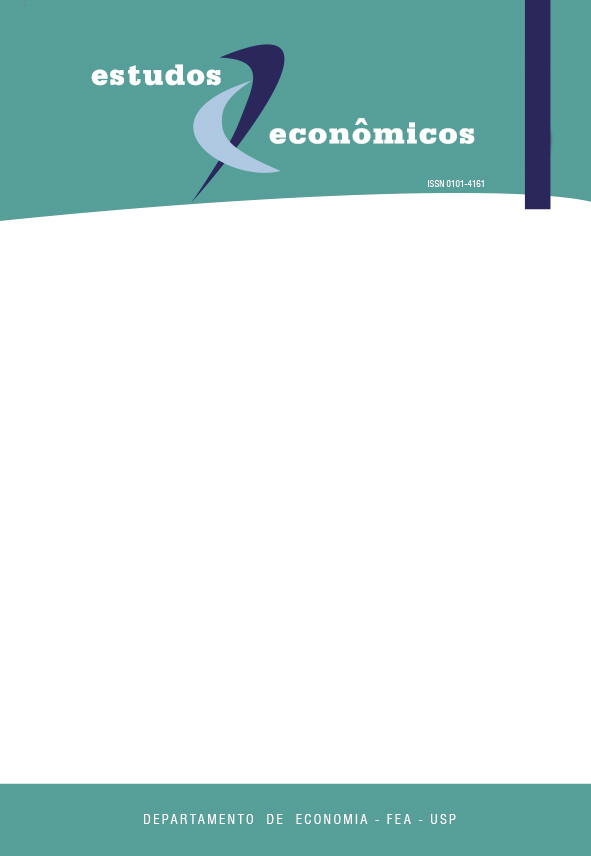Microfundamentos da Macroeconomia: notas críticas
DOI:
https://doi.org/10.1590/S0101-41612009000400006Keywords:
Macroeconomics microfoundations, pragmatism, selection criteria, MethodologyAbstract
Since the seventies, there has been a strong ressurgence of microfoundations in Economics, alongside with a change in mainstream's attitude towards theories that try to rate theories as scientific or non-scientific based on the degree of formalization and, specially, on the presence or lack of microfundations. This change has led to a gradual separation of theory and practice that seems to be harmful to economics. This paper criticizes microfoundations from two different standpoints: first, through reviewing what we call internal criticisms to microfoundations, mainly related to the misleading consequences of reductionism and of the adoption of representative agents in economic modeling; and, second, by developing external critics that highlight the impossibility of finding a priori criteria for judging theories, due to the inexistence of correct and definitive foundations of knowledge. Last, the pragmatic perspective is presented as an alternative.Downloads
References
BARBOSA, L.; CUNHA, A.; SALLU M, A. Competitive equilibrium hyperinflation
under rational expectations. Economic Theory, v. 29, n. 1, p. 181-195, Sept. 2006.
BEST, J.; WIDMAIER, W. Micro- or macro-moralities? Economic discourses and
policy possibilities. Review of International Political Economy, v. 13, n. 4, p. 609-631, Oct. 2006.
BACKHOUSE, Roger E.; BOIANOVSKY, Mauro. Whatever happened to Microfoundations.
version 1, Aug. 2005. Unpublished typescript.
BRESSER-PEREIRA, L. A verdade e seus objetos. 2006. Disponível em:
www.bresserpereira.org.br>. Acesso em: 19/11/2009.
BULLARD, J.; BUTLER, A. Nonlinearity and chaos in economic models: implications for policy decisions. The Economic Journal, v. 103, n. 419, p. 849-867, July, 1993.
CERQUEIRA, H. Adam Smith e seu contexto: o Iluminismo escocês. VIII Encontro de Economia da Região Sul - ANPEC SUL, 2005.
DAVIDSON, P. John Maynard Keynes. London and New York: Palgrave/Macmilan
Publishers, 2007. (book in the Great Thinkers in Economics series being published
by Palgrave).
GREIF, A. Institutions and the path to the modern economy: lessons from medieval trade.
Cambridge ; New York: Cambridge University Press, 2005.
HAHN, F.; NEGISHI, T. A theorem on non-tatonnement stability. Econometrica, v.30, n. 3, p. 463-469, July 1962.
HANDS, D. W. Reflection without rules: economic methodology and contemporary science
theory. 1st ed. Cambridge, England: Cambridge University Press, 2001.
HICKS, J. IS-LM: an explanation. Journal of Post Keynesian Economics, v. 3, n. 2, p.139-154, Winter 1981.
HOOVER, K. Is macroeconomics for real? The Monist, n. 78, p. 235–57, 1999.
HOOVER, K. The methodology of empirical Macroeconomics. Cambridge, UK ; New
York, NY: Cambridge University Press, 2001.
HOOVER, K. Microfoundations and the ontology of Macroeconomics. In: Kincaid,
Harold; Ross, Donald (Ed.). Oxford handbook of the Philosophy of Economic Science.
Oxford: Oxford University Press, 2006.
KEYNES, J. M. General theory of employment, interest and money”. Macmillan Cambridge
University Press, 1936.
KIRMAN, A. Whom or what does the representative individual represent? The Journal
of Economic Perspectives, v. 6, n. 2, p. 117-136, Spring 1992.
KYDLAND, F. E.; PRESCOTT , E. C. Rules rather than discretion: the inconsistency
of optimal plans. The Journal of Political Economy. v. 85, n. 3, p. 473-492, June
LU CAS, R. Understanding business cycles. In: Brunner, K.; Meltzer, H. (Ed.).
Stabilization of the domestic and international economy. Carnegie-Rochester
Conference Series on Public Policy 5. Amsterdam: North-Holland. p. 7-29.
LU CAS, R. E.; SARGENT, T. J. After keynesian macroeconomics. Federal Reserve
Bank of Minneapolis Quaterly Review, v. 3, n.2, p. 1-16, Mar. 1978.
MANKIW, N. G. The macroeconomist as scientist and engineer. NBER Working Paper Series, June 2006. (Working Paper n. 12349).
MARSHALL, A. Principles of economics. London: Macmillan and Co. Ltd, 1920.
MCCLOSKEY, D. N. The rethoric of economics. Journal of Economic Literature, v.XXI, p. 481-517, June 1983.
OLIVEIRA LIMA, L. Relatório de pesquisa n. 33/1997. Núcleo de Pesquisas e Publicações,
FGV, 1997.
ORPHANIDES, A. Historical monetary policy analysis and the Taylor rule. Carnegie-Rochester Conference, Nov. 2002.
QUINE, W. V. Main trends in recent philosophy: two dogmas of empiricism. The Philosophical Review, v. 60, n. 1, p. 20-43, Jan. 1951.
RORTY, R. Philosophy and the mirror of nature. 1st ed. Princeton: Princeton University
Press, 1979. Paperback.
RORTY, R. Philosophy and social hope. 1st ed. New York: Penguin Books, 1999.
RORTY, R. Take care of freedom and truth will take care of itself: interviews with Richard Rorty.
Eduardo Mendieta (Ed.). 1st ed. Stanford: Stanford University Press, 2006.
SNOWDON, B.; VANE, H. Modern macroeconomics: its origins, development and current state. Edward Elgar, 2005.
VERCELLI, A. Methodological foundations of macroeconomics: Keynes and Lucas. 1st
ed. Cambridge, England; New York: Cambridge University Press, 1991.
Downloads
Published
Issue
Section
License
Copyright (c) 2009 duardo Ferreira Jardim, Guilherme Lichand, Paulo Gala

This work is licensed under a Creative Commons Attribution-NonCommercial 4.0 International License.
By submitting an article, the author authorizes its publication and attests that it has not been submitted to any other journal. The original article is considered final. Articles selected for publication are proofread for grammatical and orthographic errors. The journal does not pay rights for published articles. The Institute of Economic Research from the School of Economics, Business and Accounting of the University of São Paulo (Instituto de Pesquisas Econômicas da Faculdade de Economia, Administração e Contabilidade da Universidade de São Paulo) owns the journal's copyright.




